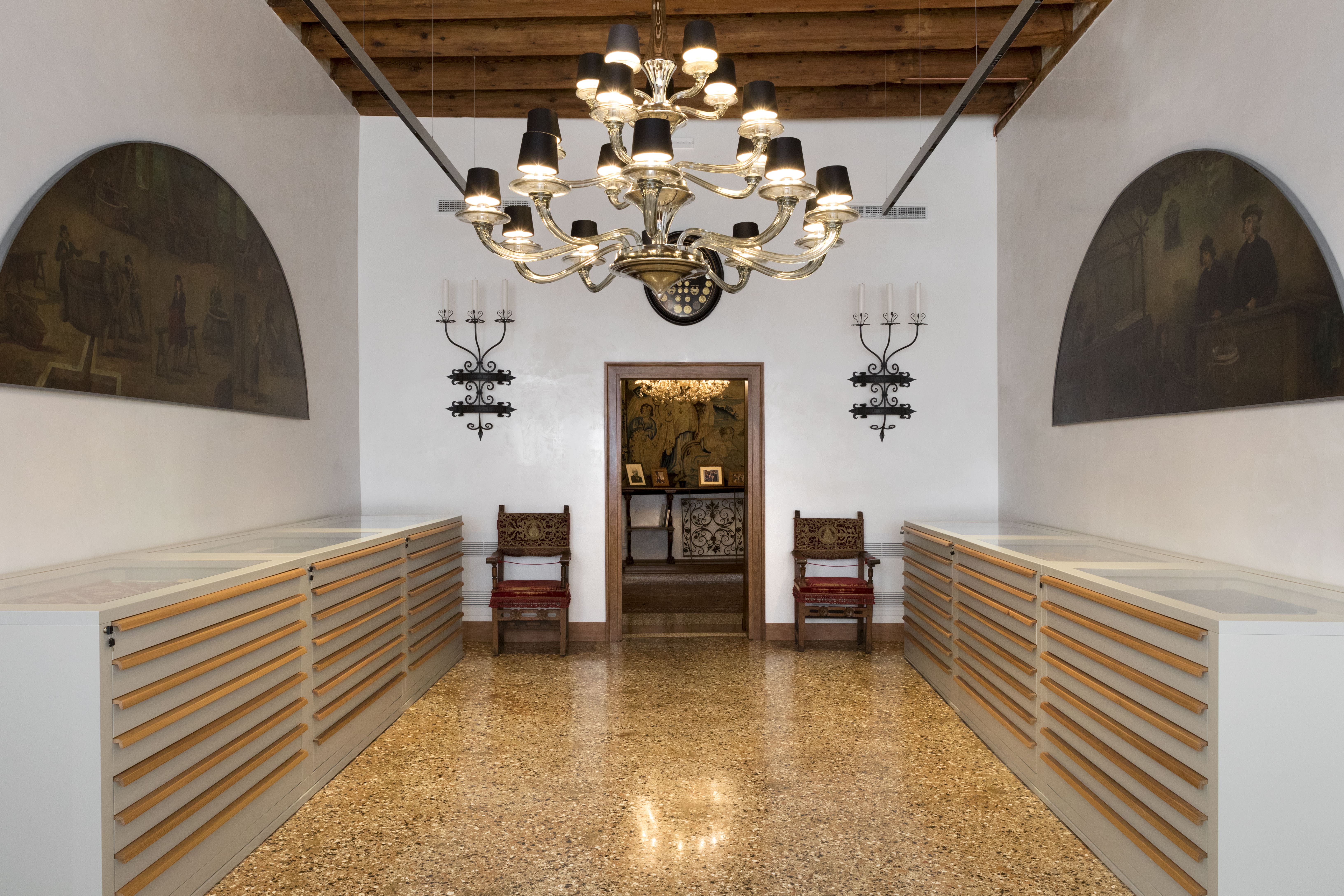
Photo courtesy Rubelli Group.
Among the treasures that Venice conceals in its streets, there is a place that witnesses the close interrelationship between the present and the past of the territory: in the Saint Mark district, in Ca' Pisani Rubelli, has place the historical seat of the Tessitura Rubelli, one of the last two oldest weaving mills remained in the lagoon and still in activity.
Pictures taken during our visit to Palazzo Pisani Rubelli.
Entering the showroom and letting yourself be guided by the gaze that passes quickly from one fabric to another, you can be overcome by a strong sense of astonishment, but this sense of wonder dictated by the infinite variety of patterns and textures - a tactile as well as visual experience – cannot, and must not, stop there. In fact, an elegant staircase leads to the highest floors of the building, where the Rubelli Foundation has been based for a few years now. Here is preserved, archived and, above all, will be exhibited, the astonishing number of more 50,000 units of fabric samples, drawings, documents and sketches which, in a lively interweaving, tell the story of Rubelli's productions.
Visiting the rooms that preserve and host this heritage means passing under the watchful eye of the portrait Lorenzo Rubelli – founder of the company –, a sort of necessary reverence before discovering the intimate variety that is hidden in the palace. Thus, one is introduced into a room where, framed by a very precious table and a series of wall paintings, there are some coffered pieces of furniture that preserve fabrics of extraordinary artisanal quality. From priest’s robes preciously decorated with beautiful figures and woven with gold threads, to small remnants of samples of past centuries, passing through cochineal fabrics of unforgettable workmanship that use to adorn the Doge’s clothes, up to reach much more recent productions.
Rubelli showrooms in Venice and Milan.
Photo courtesy Fondazione Rubelli and Rubelli Group.

Photo courtesy Fondazione Rubelli.

Photo courtesy Fondazione Rubelli.


The environments that one encounters here, weave a continuous dialogue with those who pass through them: walls enriched with magnificent damask velvets, chair upholstered and exquisitely finished, furnishings that raise curiosity not so much because of particular decorative apparatus (as if they were missing), but because they make the immense amount of knowledge and technical ability that lies behind this type of production almost self-evident. A refined, delicate, precious work that testifies the vision that has always characterized Tessitura Rubelli.
In fact, the expression created by Lorenzo Rubelli himself – ‘Stay in time’ – is the cornerstone of the company, showing how the productive approach was – and still is – oriented towards a clear desire to take up the past models, patterns and textures, re-presenting and re-interpreting them in a contemporary way.

Photo courtesy Rubelli Group.
As an example, we can mention the collaboration (2020) with the Venetian designer Luca Nichetto who recreated a decorative pattern, called Festa, made in the early decades of the twentieth century by the Murano artist Vittorio Zecchin. Again, we can remember the various collaborations that took place in 1934, the year in which Tessitura Rubelli, thanks to the work of Alfredo Carnelutti and Gio Ponti, was present at the Venice Biennale. The decorative motif, named ‘Modern Art’, whose original drawings are in the Rubelli Archive, takes its inspiration from the movement of emersion and immersion that the barene (sandbanks) of the Venetian lagoon undergo according to the tidal movements. This organic dimension, evidently taken up in the irregular pattern that the lines follow, underline the close interrelationship between design and territory.


(Left side) Photo courtesy Rubelli Group.
Similarly, Ponti’s production, which was named ‘Punteggiato’, was so successful during the 19th edition of the Biennale that it was published in Domus magazine. This fabric, even though it represents a very regular pattern, kind of a Roy Lichtenstein decoration ante litteram, once again renews the strong connection between Tessitura Rubelli and the territory, specifically through the choice of colours, red and gold, which have always been the image and symbol of the Venetian reality.


Bringing together the showroom, the foundation and the archive in a single place not only recalls the stylistic eclecticism and extremely high quality that has always been carried out by Tessitura Rubelli, it also recalls some of the most impressive works done: Villa La Coupole in Rome, Encore Boston Harbour Casino and Nymphenburg Castel in Munich.

Source of great pride for the Rubelli family, was the commission (2007), wanted by the Russian president Vladimir Putin, of a new curtain for the Moscow Bolshoi Theatre. The heartfelt need to update the decorations on the previous curtain, which were still strongly linked to the Soviet tradition, led to the commission being entrusted to the Rubelli company. This pharaonic work required 500 kilograms of pure gold yarn to make it and a year of work between study, design and implementation, leading to a new representation decided on the basis of the artistic design provided by the direction of the theatre.
Photo courtesy Rubelli Group.

Visiting the space of Tessitura Rubelli means stepping back in time, rediscovering the artisanal quality and prestige that made Venice central in the international manufacturing market. Textile art, a cornerstone of Venetian culture, finds its strength here and lives again through its past. In a never-ending dialogue involving past and present, tradition and innovation, history and contemporaneity, Tessitura Rubelli proves to be not only a leader in the luxury manufacturing sector but, above all, a company capable of rediscovering itself and treasuring its history to face its future.







